
Australian Shrubs

Contributor

For those who yearn to travel to far-flung places, but are hindered by life’s circumstances from satisfying those longings, try my approach: bring those distant worlds to your doorstep by adding plants from those countries to your garden. Lately, I’ve been enjoying a virtual sojourn in Australia, where the mediterranean climates of the southern and southwestern parts of the continent offer a wealth of plants suitable for the San Francisco Bay Area and coastal California. The regions around Melbourne, Adelaide, and Perth are an especially rich source of flowering shrubs, many of which have made their way into the nursery trade—and into my own Oakland garden.
The flora of the mediterranean-climate and adjoining semi-arid regions of Australia is far ranging and varied, but there are a few common qualities that help the shrubs from these regions stand apart, and make them of particular value to California gardens. They are almost universally tough plants, not only drought tolerant but adapted to nutrient-poor soils. Many are accustomed to harsh conditions of heat, drought, and coastal wind, and have developed successful survival strategies, such as leathery or waxy leaves, slender needle-like leaves, silvery or woolly leaves, thick bark, and deep or wide-spreading roots—not unlike our own California native plants.
When considering the addition of Australian shrubs to your garden, pay particular attention to the texture, shape, and color of the leaves. The diversity of leaf shape is impressive, even within a single genus like Grevillea, where the leaves may be oak-like (G. barklyana), pinnately lobed (G. robusta), oval (G. laurifolia), stiff and needle-like (G. juniperina), or soft and woolly (G. lanigera).
Choosing the Shrubs
One could group the vast array of Australian shrubs in any number of ways, such as foliage character and flowering season, but it is most practical to organize them by size. For purposes of this article, I have divided them into three groups: smaller (one to four feet tall), mid-size (four to seven), and large (seven to twenty). All of the shrubs discussed here are evergreen. Sunset zones are presented in brackets, where known.
For the smaller garden, there is a selection of attractive but tough, compact shrubs. Start with the spreading sub-shrub called Swan River pea (Brachysema celsianum), for its bright red pea-like flowers encased in silvery calyxes. The lanceolate leaves open a bright green but age to a silvery gray. This versatile shrub can be used as a dense ground cover on slopes or to cascade over a low rock wall; it can also be trained to climb a small trellis or be pruned to form a dome-shaped bush. Many of these qualities hold true for the heart-leaved flame pea (Chorizema cordatum), whose small orange red flowers open wide and are produced in such numbers as to nearly hide the foliage. This low shrub, up to three feet unless pruned, benefits from a bit of water and relief from the intense midday heat during summer. It’s more of a scrambler and can be utilized as an understory planting to cover the ground. It is also showy enough to be featured in large containers. [15-17, 19-24]

The genus Correa, known as Australian fuchsia for its colorful, nodding, tubular flowers produced from autumn through early spring, is most widespread in southern Australia. The plants have simple bright green to grayish green, oval leaves, and range in height and spread from three to six feet. Dense enough to be used as a low hedge, usually wider than tall, correas offer gardeners a sturdy, long-blooming shrub for a variety of purposes. Popular cultivars include ‘Dusky Bells’, with dusky pink blooms on broad three-foot mounds, ‘Ivory Bells’, with off-white flowers on slightly taller shrubs, and the low-growing, eye-catching ‘Ray’s Tangerine’, which was hybridized by Ray Collett. [14-24]
The fragrant boronias hail from Western Australia, where Boronia megastigma is highly prized for its intensely fragrant flowers and aromatic foliage. This species features fine, needle-like leaves on upright stems that will reach three to five feet in height. It blooms in the spring, with masses of tiny red brown and yellow cup-shaped nodding flowers. This boronia wants well-drained soil but regular irrigation. [15-17, 20-24]
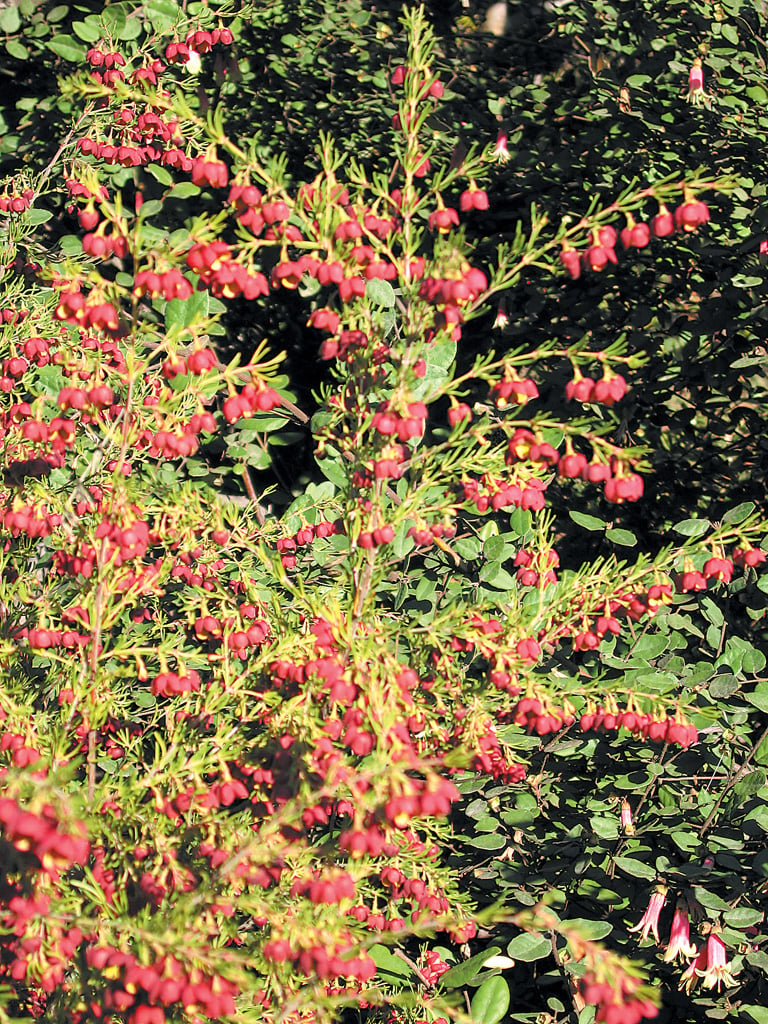
Swainsona formosa showcases woolly, grayish green, pinnately compound leaves, providing a lush backdrop for spectacular heads of large, shiny red, pealike flowers. The flowers are curious for the black bosses, or bumps, in their centers. Verticordia plumosa features delicate, linear, bluish green leaves and masses of charming pink flowers in late winter. It has an attractive willowy form and is modest enough, to three feet in height, to fit into a variety of planting situations, provided they are in full sun. [16, 17, 22-24]
Mid-sized Gems
Selections in the middle range give just a hint of the great variety found in shrubs native to Australia. Consider the showy mint bushes (Prostanthera) for a prominent spot in your garden. Most have highly aromatic oval or lance-shaped green leaves and small white, pink, or reddish purple flowers. Purple mint bush (P. ovalifolia) is especially suited to our West Coast climate, reaches six feet in height, and will be a fine addition to the fragrance garden. A more modest grower is the variegated selection of purple mint bush (P. ovalifolia ‘Variegata’).
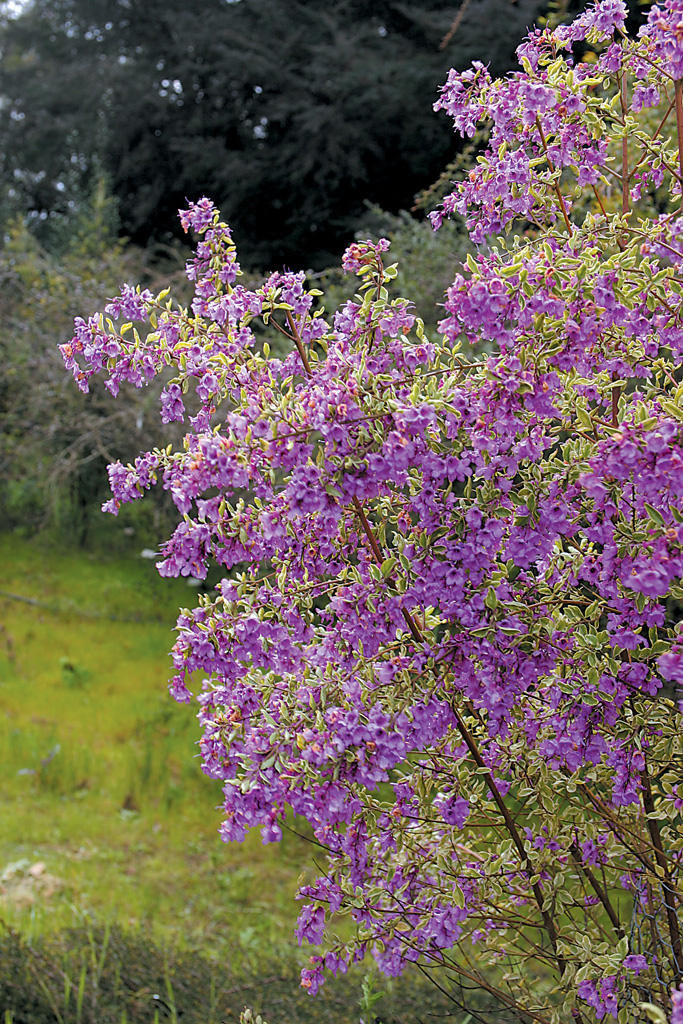
With a more open habit, Geraldton wax flower (Chamelaucium uncinatum) is known for its abundant and long-lasting sprays of waxy, inch-wide flowers that are so popular with florists. Each flower has five rounded, spreading petals and cup-shaped centers; hybridizing work has resulted in a range of colors from pure white through pinks to red and lavender. Flowering begins in late spring and lasts into late summer. Plants can reach six feet in height, with attractive, needle-like, aromatic leaves. They are showy enough to serve as focal points and open enough to work into a mixed shrubbery. [8-9, 12-24]
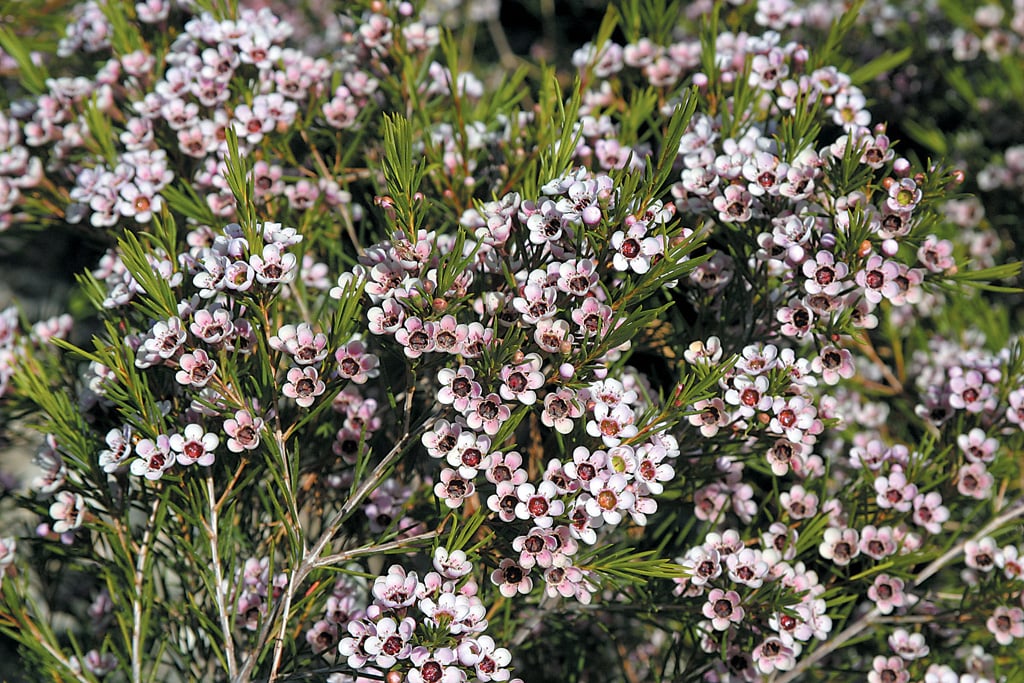
The protea family is big in Australia and includes countless species in the genera Grevillea, Banksia, and Hakea. One less common but charming genus is Isopogon. Rose coneflower (I. formosus) is named for its pincushion-like, rosy pink, two-inch flower heads. Upright stems, to about six feet, are covered with finely divided and somewhat prickly green leaves. The distinctive, rounded knob-like fruits have given members of this genus the nickname drumsticks. [15-24]
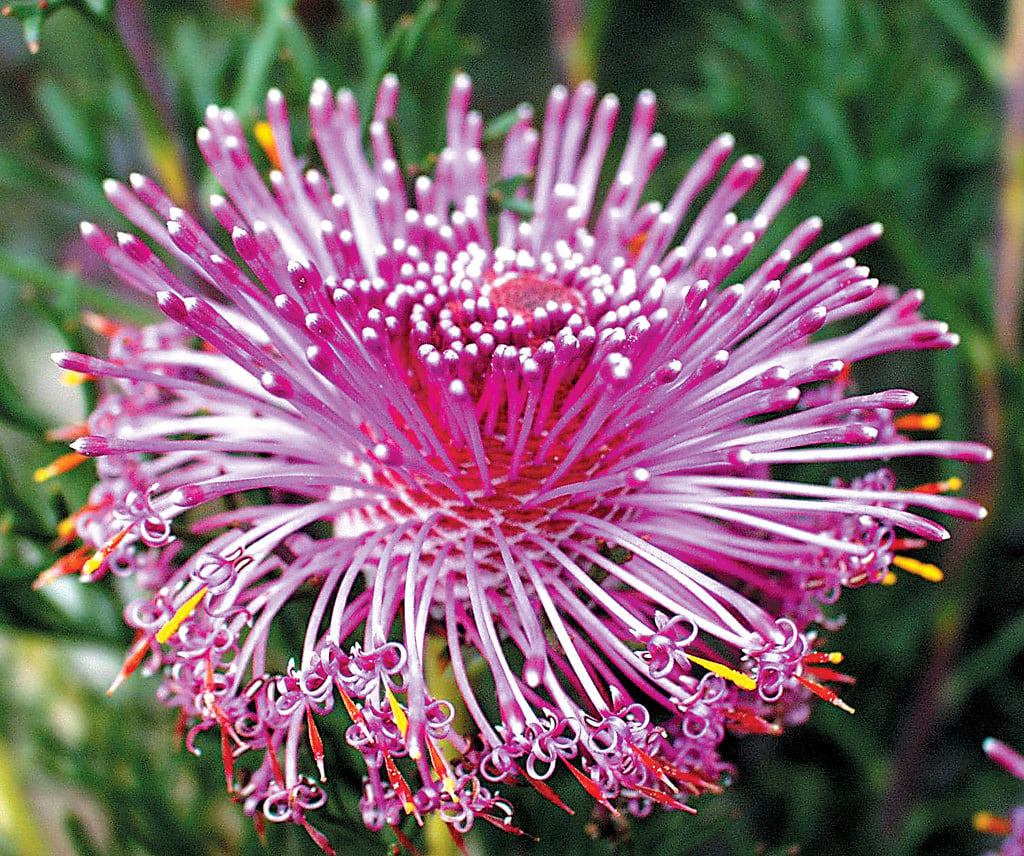
Australian bluebells (Sollya heterophylla) is a twining shrub, with small, glossy green, narrowly ovate leaves, against which spring masses of tiny, true blue, bell-shaped flowers from early summer into the fall. It will happily climb a trellis or will remain a dense, compact bush with a little pruning. It does prefer a bit more summer water than most Australian shrubs, but it is hardy and makes do with less water once established. [8, 9, 14-24]
Statement Selections
For those with room in their gardens for larger shrubs, or for those looking for a single, dramatic statement, Australia offers plenty of choices. The genus Leptospermum may be best known for New Zealand’s colorful and floriferous tea tree (L. scoparium). From Australia comes a stunning version of tea tree in L. rotundifolium, with the largest flowers in the genus. Varying from white to purplish pink, the inch-wide blossoms, full of nectar and popular with bees and hummingbirds, hide the tiny, rounded leaves in spring, on arching shrubs of six to eight feet in height. [14-24]
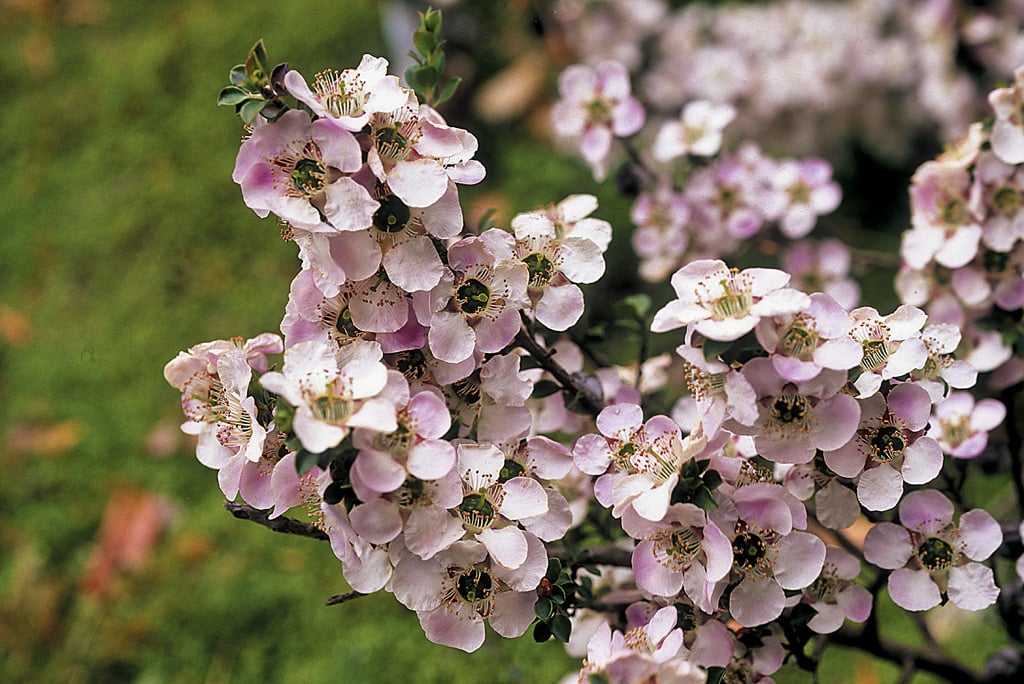
Bottlebrushes are common in the California landscape, thanks to the widely planted lemon bottlebrush (Callistemon citrinus), whose instantly recognizable bright red flowers cover the bush in successive waves through much of the year. Its leaves emit a strong lemon scent when crushed. If the typical color is too intense, look for named selections with crimson, mauve, or pink flowers. Hummingbirds will never be far away when the bottlebrushes are in bloom. [8, 9, 12-24]
Heath banksia (Banksia ericifolia) is the most easily grown of the seventy or so species of this striking genus in the protea family. It’s narrow, heath-like leaves, green on top and silvery beneath, densely cloth the upright stems. Orange to red, eight-inch-tall, corncob-shaped inflorescences appear from fall through spring, appealing to hummingbirds for their rich store of nectar. Spectacular when in bloom, these hardy shrubs can reach fifteen feet, although dwarf cultivars have become available. [15-24]
If it’s beauty and variety you’re looking for, search no further than the genus Grevillea. This massively successful genus (250 species) in the protea family has, as noted earlier, an impressive array of leaf forms and flower types. There are selections ranging from prostrate mounds to rounded shrubs to upright shrubs and trees. For a good review, return to the October 2011 issue of Pacific Horticulture for two articles on grevilleas.
I love to share black coral pea (Kennedia nigricans) with those not already lucky enough to have discovered it. Describing its flowers as dramatic is like saying Renoir could paint. Actually, the more appropriate painter reference might be Rousseau, famous for his vivid jungle scenes and use of saturated colors. This vigorous (ie, not for small gardens) climber produces four-inch, ovate, dark green leaflets, but the real show is the display of velvety black flowers, their standard petals reflexed and boldly splashed with yellow. These are among the blackest flowers in the plant world.
Landscape Considerations
Australian natives provide the Bay Area and coastal California gardener with a variety of qualities that can be utilized in the landscape. Needle-leafed or narrowly pointed leaves on many selections offer a contrast to the majority of western shrubs with broader leaves, and fit nicely into a low-water garden. Many of the shrubs also offer attractive gray or silvery foliage, also likely to suggest greater tolerance of drought; such foliage provides a delightful contrast to the colorful flowers, as is the case with Swan River pea and a number of the grevilleas.
Australian native shrubs are valuable for extending foliar and floral interest into late fall, winter, and early spring. Plants such as heath banksias and heart-leaved flame pea bloom in the fall, followed by Correa through the winter and Verticordia and Grevillea in early spring. One can also use some of the shrubs to add distinctive scents to a fragrant garden, choosing one of the bottlebrushes, a mint bush, or the heavenly scented boronias.
Although these Australian shrubs are imports to California, they are appreciated by a host of general pollinators, in part because the flowers are high in nectar. Honeybees, bumblebees, and hummingbirds will be frequent visitors to shrubs such as tea trees, Geraldton wax flower, grevillea, and correa.
Care and Feeding
Australian shrubs are among the easiest plants to get established and to care for. Primarily sun loving, many will tolerate partial shade. They are accustomed to worn out, ancient soils back home and generally demand good drainage (clay soils can be a problem). Some prefer a slightly alkaline pH, but many are happiest in slightly acidic soils. Most Australian natives grow in soils that are exceedingly low in that element, so avoid fertilizers high in phosphorus; this is especially important with members of the protea family, such as Grevillea, Isopogon, and Banksia.
Most Australian shrubs are cold hardy enough to handle the winter temperatures of the Bay Area and along the California coast. A few, such as Chorizema and Prostanthera, might be too tender for those gardens that regularly experience hard frosts.
The most challenging question in considering whether to add an Australian native to your garden may simply be how many you have room for. How much time do you want to spend “down under?”
Share:
Social Media
Garden Futurist Podcast
Most Popular
Videos
Topics
Related Posts

Ground Up Science for Greener Cities with Garden Futurist Dr. Alessandro Ossola
Spring 2023 Listen to the Podcast here. Alessandro Ossola is a scientist who gets very excited about the challenge of climate change allowing for an

Readying Urban Forests for Climate Realities with Garden Futurist Dr. Greg McPherson
Winter 2023 Listen to the Podcast here. “Going from the mow and blow to a more horticulturally knowledgeable approach to maintaining the landscape. And that

Welcome, Greywater, to the Garden
Summer 2022 Oh, summer: delightful warm air, tomatoes swelling on the vine, fragrant blooms on an evening stroll. When it’s warm and rainless, how is

Big Tree-Data and Big-Tree Data with Garden Futurist Matt Ritter
Summer 2022 Listen to the full Garden Futurist: Episode XV podcast here. We are in an environmental crisis right now in many parts of California











Responses